Example analysis of generics and wildcards in Java
Digression: Generics and wildcards are two of the more difficult syntaxes in Java grammar. The main purpose of learning generics and wildcards is to be able to I understand the source code but don’t actually use it much.

1. Generics
1.1 Usage of generics
1.1.1 Concept of generics
《 There is a saying in "Java Programming Thoughts": General classes and methods can only use specific types: either basic types or custom classes. If you want to write code that can be applied to multiple types, this rigid restriction will be very restrictive to the code. So starting from Java5, the generic mechanism was introduced. What does this generic mean? Since general classes and methods can only use one specific type, this puts great constraints on the code. For example, a method to find the maximum value of three numbers. Assume that the type of the parameter list in the method at the beginning is Integer, you have no problem finding the maximum value from three integer data, this program can run perfectly, but when you want to find the maximum value among three floating point numbers, this program compiles successfully However, at this time, you can choose to write another overloaded method and implement the parameter list and implementation function based on Double. This can also solve the problem. However, have you ever thought about a problem? What if there is one? Ten thousand or even one million types need the largest of the three objects. What should we do, write a million overloaded methods? This is impossible. In order to solve this type of problem, generics were introduced. Generics implement the concept of parameterized types, allowing the code to apply multiple types. Generally speaking, generics are "applicable to many, many types" mean. Generics can be used to pass types as "parameters" to classes, interfaces, and methods, so that classes and methods can have the widest expression capabilities, and there is no need to create another type just because a parameter is different.
Note: Any basic type cannot be used as a type parameter.
1.1.2 Generic classes
We can understand generics through a piece of code. First, look at the following piece of code that does not use generics:
/**
* 不使用泛型
*/
class A {
}
class Print {
private A a;
public Print(A a) {
setA(a);
System.out.println(this.a);
}
public void setA(A a) {
this.a = a;
}
public A getA() {
return this.a;
}
}
public class Generic {
public static void main(String[] args) {
Print print = new Print(new A());
}
}//output:A@1b6d3586
There is no problem in creating a class without using generics, but the reusability of this class is not very good. It can only hold class A objects cannot hold objects of any other class. We do not want to write a new class for every type encountered. This is unrealistic. When we study classes, we know that the Object class is the parent class of all classes, so the Object class can accept all type references, and we can make the Print class hold There are objects of type Object.
/**
* 使用Object类
*/
class B{ }
class Print1 {
private Object b;
public Print1(Object b) {
setB(b);
System.out.println(this.b);
}
public void print(Object b) {
setB(b);
System.out.println(this.b);
}
public void setB(Object b) {
this.b = b;
}
}
public class Generic1 {
public static void main(String[] args) {
Print1 print1 = new Print1(new B());//打印B类型
int i = 2022;
print1.print(i);//打印整型类型
print1.print("这是一个字符串对象!");//打印字符串类型
}
}//output:
//B@1b6d3586
//2022
//This is a string object!
Print1 can receive and print any type, but this is not the result we want. Think about it if you implement a sequence table class, which uses an array. To achieve this, if this array can receive any type, it will be very confusing. When the data is taken out, it cannot be determined what type of data is taken out, and the data taken out is of the Object class, which needs to be forced. Type conversion can specify what type of object a class holds and the compiler can check the correctness of the type. Generics perfectly achieve this purpose. Now we will rewrite the above code into a generic class. Then we must first know the syntax of generics. The syntax for creating a generic class is as follows:
class class name< Generic parameter list> {
Permission modified generic parameter variable name;//Generic member variable
Permission modified return value type method name (parameter list){}//Parameter list and return value type can be Generic
}
For example:
class Print2<T> {
private T c;
public void print(T c) {
setC(c);
System.out.println(this.c);
}
public void setC(T c) {
this.c = c;
}
}The syntax for using a generic class is as follows:
Generic class
new generic class (constructor argument); //instantiate a generic class object
For example:
Print2<Integer> print3 = new Print2<Integer>();
Use generics to implement a class and use it:
/**
* 使用泛型
*/
class C{ }
class Print2<T> {
private T c;
public void print(T c) {
setC(c);
System.out.println(this.c);
}
public void setC(T c) {
this.c = c;
}
}
public class Generic2{
public static void main(String[] args) {
Print2 print2 = new Print2<>();//打印C类型
print2.print(new C());
Print2 print3 = new Print2<>();//打印整型类型
print3.print(2022);
Print2 print4 = new Print2<>();//打印字符串类型
print4.print("这是一个字符串对象!");
}
} /**
* output:
*C@1b6d3586
* 2022
* This is a string object!
*/
Class name The <T> after it represents a placeholder, indicating that the current class is a generic class.
[Specification] Type parameters are generally represented by a capital letter. Commonly used names are:
E represents Element
K represents Key
V represents Value
N represents Number
T represents Type
S, U, V, etc. - the second, third and fourth type
//一个泛型类
class ClassName<T1, T2, ..., Tn> { } When using a generic class, specify the type held by the object of this class, then the object can only receive objects of this type. If other types of objects are passed in, the compiler will report an error and receive the return of the generic method in the generic class. When using a value, no forced type conversion (downcasting) is required, while using the Object class requires forced type conversion.
1.1.3类型推导
使用泛型类时,可以通过泛型类型中传入的类型来推导实例化该泛型类时所需的类型参数,换个说法,定义泛型对象时,前面的尖括号内必须指定类型,后面实例化时可以不指定。如:
Print2<Integer> print3 = new Print2<>();//后面尖括号内可省略
1.2裸类型
裸类型其实很好理解,就是一个泛型类,你不去指定泛型对象持有的类型,这样的一个类型就是裸类型。 比如:
public static void main(String[] args) {
Print2 print2 = new Print2();
print2.print(2022);
print2.print("字符串");
}//output:
//2022
//字符串
我们不要自己去使用裸类型,裸类型是为了兼容老版本的 API 保留的机制。
1.3擦除机制
1.3.1关于泛型数组
介绍泛型的擦除机制之前,我们先来了解泛型数组·,先说结论,在Java中不允许实例化泛型数组,如果一定要建立一个泛型数组,正确的做法只能通过反射来实现,当然有一个“捷径”可以不使用反射来创建泛型数组。创建的代码如下:
1.通过捷径创建,大部分情况下不会出错。
public class MyArrayList<T> {
public T[] elem ;
private int usedSize;
public MyArrayList(int capacity) {
this.elem = (T[])new Object[capacity];
}
}2.通过反射创建,现在只给代码,具体为什么要这么做后续介绍反射再说。
public class MyArrayList<T> {
public T[] elem ;
private int usedSize;
public MyArrayList(Class<T> clazz, int capacity) {
this.elem = (T[]) Array.newInstance(clazz, capacity);
}
}1.3.2泛型的编译与擦除
我们先来实现一个简单的泛型顺序表,不考虑扩容问题,只实现简单的增删操作,来看看构造方法部分编译后的反汇编。
import java.lang.reflect.Array;
public class MyArrayList<T> {
public T[] elem ;
private int usedSize;
public MyArrayList(int capacity) {
this.elem = (T[])new Object[capacity];
}
public MyArrayList(Class<T> clazz, int capacity) {
this.elem = (T[]) Array.newInstance(clazz, capacity);
}
}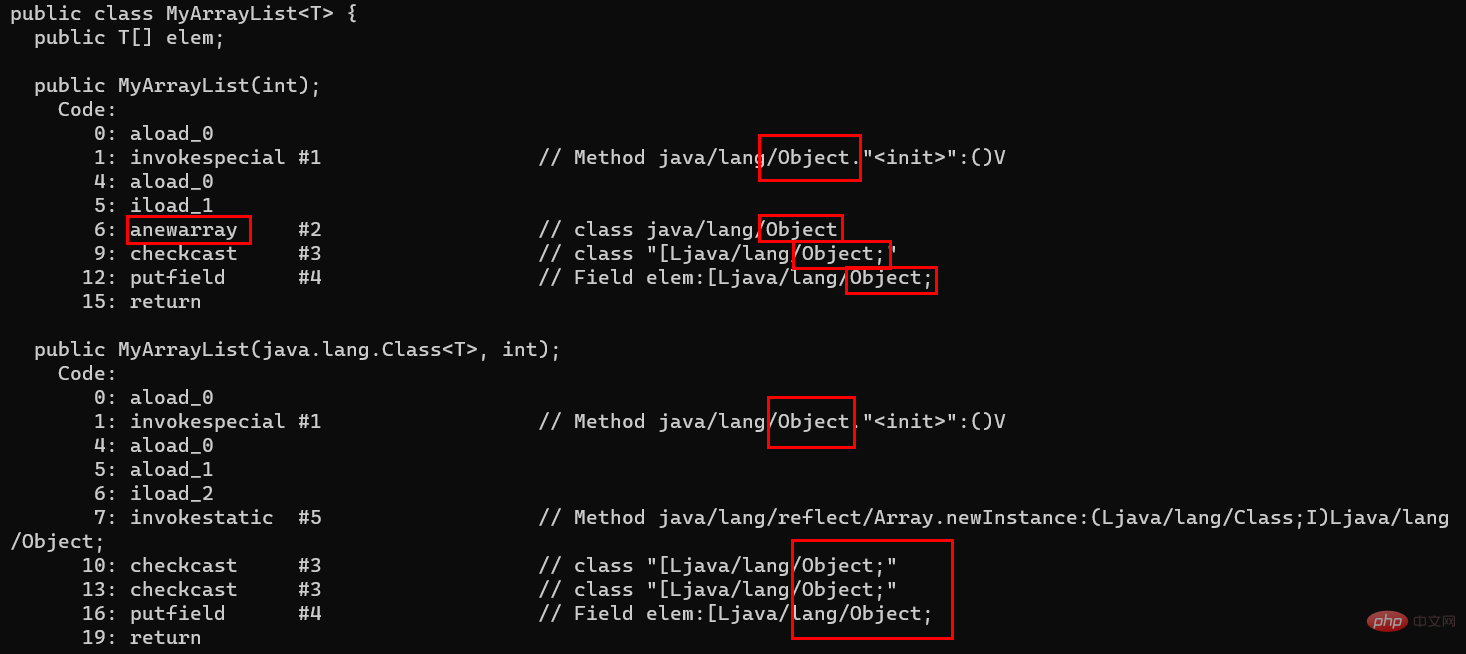
我们发现所有的泛型占位符T都被擦除替换成Object了,这就说明Java的泛型机制是在编译期实现的,而泛型机制实现就是通过像这样的擦除机制实现的,并在编译期间完成类型的检查。
我们通过打印持有不同类型的MyArrayList类来看看,泛型机制到底是不是不会出现在运行期间,如果是的话,打印出的类型都应该是MyArrayList。
public static void main(String[] args) {
MyArrayList<Integer> list1 = new MyArrayList<>(10);
MyArrayList<String> list2 = new MyArrayList<>(10);
System.out.println(list1);
System.out.println(list2);
}/**
* output:
* MyArrayList@1b6d3586
* MyArrayList@4554617c
*/
我们发现打印的类型是一样的,都是MyArrayList,所以可以得出一个结论,泛型是发生在编译期,泛型的类型检查是在编译期完成的,泛型的实现是通过擦除机制实现的,类后面的占位符都会被擦除,其他的占位符都会被替换成Object。当然,这是在泛型参数没有指定上界的情况下,如果存在上界,那占位符会擦除成上界的类型或接口,其实没有指定上界,上界默认为Object,什么是泛型上界,嘘,等一下再说。
根据擦除机制,也能解释为什么Java当中不能实例化泛型数组了,因为泛型数组前面的占位符会被擦除成Object,实际上是创建一个Object数组,而Object数组中什么类型都能放,这就导致取数据时不安全,因为你不能确定数组里面存放的元素全部都是你预期的类型,所以为了安全,Java不允许实例化泛型数组。
1.4泛型的上界
1.4.1泛型的上界
在定义泛型类时,有时需要对传入的类型变量做一定的约束,可以通过类型边界来约束。
class 泛型类名称<类型形参 extends 类型边界> {
...
}
例如:Number是Integer,Float,Double等相关数字类型的父类。
public class MyArrayList<T extends Number> {
}那么这个MyArrayList泛型类只能指定持有Number类以及Number的子类,像这样就给泛型的类型传参做了约束,这个约束就是泛型的上界,泛型类被类型边界约束时,只能指定泛型类持有类型边界这个类及其子类。
MyArrayList<Integer> list1 = new MyArrayList<>(10);//正确
MyArrayList<Double> list2 = new MyArrayList<>(10);//正确
MyArrayList<String> list3 = new MyArrayList<>(10);//错误,因为String不是Number的子类1.4.2特殊的泛型上界
假设需要设计一个泛型类,能够找出数组中最大的元素。
class MaxVal<T extends Comparable<T>> {
public T max(T[] data) {
T max = data[0];
for (int i = 0; i < data.length; i++) {
if (max.compareTo(data[i]) < 0) max = data[i];
}
return max;
}
}由于引用类型的比较需要使用Comparable接口来判断大小,所以所传入的类需要实现Comparable接口,上面这个泛型的类型参数的上界是一个特殊的上界,表示所传入的类型必须实现Comparable接口,不过实现了Comparable接口的类,那也就是Comparable的子类了,综上,像这样类似需要通过实现某一个接口来达到预期功能的类型,使用泛型时需指定泛型的上界,并且该传入的类型必须实现该上界接口。
1.4.3泛型方法
有泛型类,那么就一定有泛型接口,泛型方法,其中泛型接口与泛型类的创建和使用是一样的,所以我们重点介绍泛型方法的创建与使用。 创建泛型方法的基本语法:
方法限定符 <类型形参列表> 返回值类型 方法名称(形参列表) { ... }
例如上面实现求数组中最大元素泛型版的方法如下:
class MaxVal<T extends Comparable<T>> {
public <T extends Comparable<T>> T max(T[] data) {
T max = data[0];
for (int i = 0; i < data.length; i++) {
if (max.compareTo(data[i]) < 0) max = data[i];
}
return max;
}
}对于非static修饰的静态方法, <类型形参列表>可以省略,上述代码可以变成:
class MaxVal<T extends Comparable<T>> {
public T max(T[] data) {
T max = data[0];
for (int i = 0; i < data.length; i++) {
if (max.compareTo(data[i]) < 0) max = data[i];
}
return max;
}
}但是,如果是一个static修饰的静态方法,<类型形参列表>不可以省略,因为静态方法不依赖与对象,它的使用不用实例化对象,所以必须有单独的类型参数列表来指定持有的对象类型。
class MaxVal<T extends Comparable<T>> {
public static <T extends Comparable<T>> T max(T[] data) {
T max = data[0];
for (int i = 0; i < data.length; i++) {
if (max.compareTo(data[i]) < 0) max = data[i];
}
return max;
}
}1.4.4类型推导
和泛型类一样,泛型方法也有类型推导的机制,如果不使用类型推导,那么泛型方法是这么使用的:
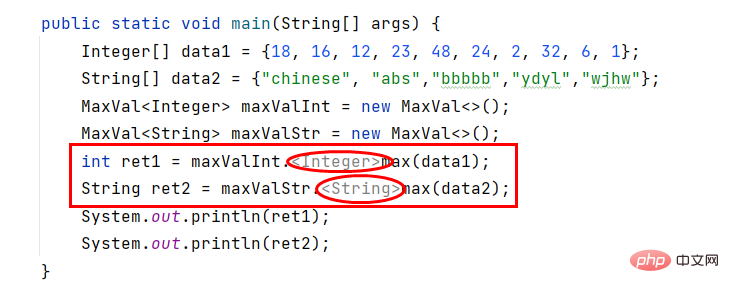
使用类型推导图中画圆圈部分可以省略。
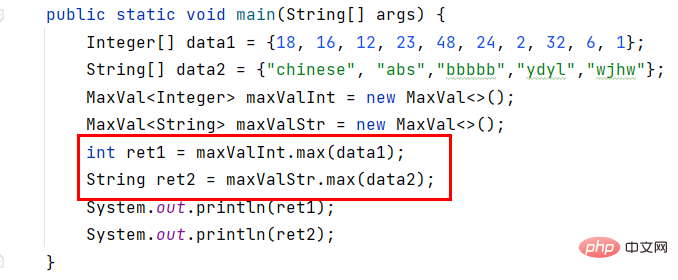
在泛型类中没有如下的父子类关系:
public class MyArrayList<E> { ... }
// MyArrayList<Object> 不是 MyArrayList<Number> 的父类型
// MyArrayList<Number> 也不是 MyArrayList<Integer> 的父类型但是使用通配符这两种类是有符子类关系的。
2.通配符
2.1通配符的概念
?就是一个通配符,用与泛型的使用,与泛型不同的是,泛型T是确定的类型,传入类型实参后,它就确定下来了,而通配符更像是一种规定,规定一个范围,表示你能够传哪些参数。 一个泛型类名尖括号之内仅含有一个?,就会限制这个泛型类传入的类型为Object,相当于没有限制,但是获取元素时由于不能确定具体类型,只能使用Object引用接收,所以<?>也被称为无界通配符。
//使用泛型打印顺序表
public static<T> void printList1(ArrayList<T> list) {
for (T x:list) {
System.out.println(x);
}
}
//使用通配符打印顺序表
public static void printList2(ArrayList<?> list) {
for (Object x:list) {
System.out.println(x);
}
}使用泛型T能够确定传入的类型就是T类型,所以使用T类型的变量接收,而通配符?没有设置边界的情况下,默认上界是Object没有下界,为了保证安全,只能使用Object类型的变量接收。
通配符是用来解决泛型无法协变的问题的,协变指的就是如果Student是Person的子类,那么List<Student>也应该是List<Person>的子类。但是泛型是不支持这样的父子类关系的。
2.2通配符的上界
通配符也有上界,可以限制传入的类型必须是上界这个类或者是这个类的子类。
基本语法:
//可以传入的实参类型是Number或者Number的子类
例如:
public static void printAll(ArrayList<? extends Number> list) {
for (Number n: list) {
System.out.println(n);
}
}我们对printAll方法的一个形参限制了类型的上界Number,所以在遍历这个顺序表的时候,需要使用Number来接收顺序表中的对象,并且使用该方法时,只能遍历输出Number及其子类的对象。
public static void main(String[] args) {
printAll(new ArrayList<Integer>());//ok
printAll(new ArrayList<Double>());//ok
printAll(new ArrayList<Float>());//ok
printAll(new ArrayList<String>());//error
}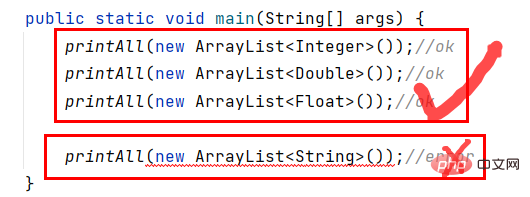
假设有如下几个类:
class Animal{}
class Cat extends Animal{}
class Dog extends Animal{}
class Bird extends Animal{}Animal是Cat,Dog,Bird类的父类,我们来看一看使用泛型和使用通配符在打印对象结果上会有什么区别?我们对这两者都设置了上界,当打印不同的对象时,到底会调用谁的toString方法。
//泛型
public static <T extends Animal> void printAnimal1(ArrayList<T> list) {
for (T animal: list) {
System.out.println(animal);
}
}
//通配符
public static void printAnimal2(ArrayList<? extends Animal> list) {
for (Animal animal: list) {
System.out.println(animal);
}
}我们先来看泛型,使用泛型指定类型后,那么指定什么类型,那它就会输出什么类型的对象,比如你指定顺序表中放的类型是Cat,那么它调用的就是Cat对象的toString方法。
public static void main(String[] args) {
Cat cat = new Cat();
Dog dog = new Dog();
Bird bird = new Bird();
//泛型
ArrayList<Cat> list1 = new ArrayList<>();
ArrayList<Dog> list2 = new ArrayList<>();
ArrayList<Bird> list3 = new ArrayList<>();
list1.add(cat);
list2.add(dog);
list3.add(bird);
printAnimal1(list1);//Cat
printAnimal1(list2);//Dog
printAnimal1(list3);//Bird
}
再来看一看通配符,使用通配符是规定能够使用Animal及其子类,不伦你传入哪一个子类对象,都是父类的引用接收,但是具体哪一个子类,并不清楚。
public static void main(String[] args) {
Cat cat = new Cat();
Dog dog = new Dog();
Bird bird = new Bird();
//通配符
ArrayList<Cat> list1 = new ArrayList<>();
ArrayList<Dog> list2 = new ArrayList<>();
ArrayList<Bird> list3 = new ArrayList<>();
list1.add(cat);
list2.add(dog);
list3.add(bird);
printAnimal2(list1);//Cat
printAnimal2(list2);//Dog
printAnimal2(list3);//Bird
}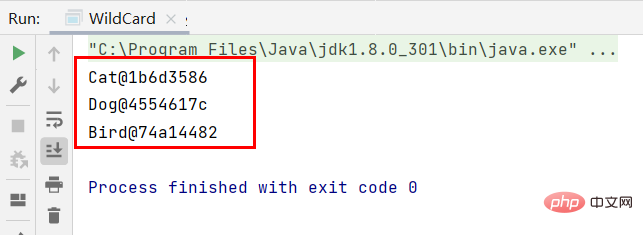
父类引用接收子类对象发生了向上转型,当打印父类引用的子类对象时,会优先使用子类的toString方法,在介绍多态的时候也讲过这个问题,所以输出结果与使用泛型是一样的,但是泛型和通配符的效果是不一样的,泛型是你传入什么类型,那这个类就会持有什么类型的对象,而通配符是规定一个范围,规定你能够传哪一些类型。
通配符的上界是支持如下的父子类关系的,而泛型的上界不支持:
MyArrayList 是 MyArrayList
或者 MyArrayList 的父类类型
MyArrayList<?> 是 MyArrayList 的父类型
对于通配符的上界有个特点,先说结论,使用通配符上界可以读取数据,但是并不适合写入数据,因为不能确定类所持有的对象具体是什么。
public static void main(String[] args) {
ArrayList<Integer> arrayList1 = new ArrayList<>();
ArrayList<Double> arrayList2 = new ArrayList<>();
arrayList1.add(10);
List<? extends Number> list = arrayList1;
System.out.println(list.get(0));//ok
Integer = list.get(0);//error因为不能确定list所持有的对象具体是什么
list.add(2);//error因为不能确定list所持有的对象具体是什么,为了安全,这种情况Java不允许插入元素
}
因为从list获取的对象类型一定Number或者Number的子类,所以可以使用Number引用来获取元素,但是插入元素时你并不能确定它到底是哪一种类型,为了安全,使用通配符上界的list不允许插入元素。
2.3通配符的下界
与泛型不同,通配符可以拥有下界,语法层面上与通配符的上界的区别是讲关键字extends改为super。
<? super Integer>//代表 可以传入的实参的类型是Integer或者Integer的父类类型
既然是下界那么通配符下界与上界对传入类的规定是相反的,即规定一个泛型类只能传入下界的这个类类型或者这个类的父类类型。比如<? super Integer>代表 可以传入的实参的类型是Integer或者Integer的父类类型(如Number,Object)
public static void printAll(ArrayList<? super Number> list) {
for (Object n: list) { //此处只能使用Object接收,因为传入的类是Number或者是Number的父类
System.out.println(n);
}
}public static void main(String[] args) {
printAll(new ArrayList<Number>());//ok
printAll(new ArrayList<Object>());//ok
printAll(new ArrayList<Double>());//error
printAll(new ArrayList<String>());//error
printAll(new ArrayList<Integer>());//error
}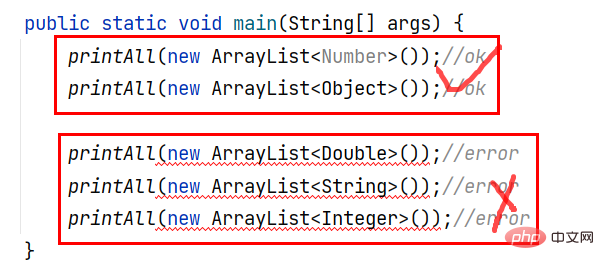
同理通配符的下界也是满足像下面这种父子类关系的。
MyArrayList<? super Integer> 是 MyArrayList
的父类类型
MyArrayList<?> 是 MyArrayList<? super Integer>的父类类型
总结: ?是? extends ....和? super ....的父类,看通配符之间的父子类关系,最关键的是看通配符所“规定的”范围,判断父子类是根据这个范围来判断的。
通配符的下界也有一个特点,那就是它能够允许写入数据,当然能够写入的数据对象是下界以及下界的子类,但是并不擅长读数据,与通配符的上界相反。
public static void main(String[] args) {
ArrayList<? super Animal> list = new ArrayList<Animal>();
ArrayList<? super Animal> list2 = new ArrayList<Cat>();//编译报错,list2只能引用Animal或者Animal父类类型的list
list.add(new Animal());//添加元素时,只要添加的元素的类型是Animal或者Animal的子类就可以
list.add(new Cat());
Object s2 = list.get(0);//可以
ArrayList<? super Animal> list3 = new ArrayList<Object>();
Cat s1 = list3.get(0);//error因为构造对象时可以构造Animal父类类型的ArrayList,取出的对象不一定是Animal或者Animal的子类
}
对于这个栗子添加元素时,只要添加的元素的类型是Animal或者Animal的子类就可以,获取元素时,只能使用Object引用接收,不能使用其他的引用接收,因为因为构造对象时可以构造Animal父类类型的ArrayList,虽然可以插入Animal以及其子类对象,但取出的对象不能保证是Animal或者Animal的子类。
The above is the detailed content of Example analysis of generics and wildcards in Java. For more information, please follow other related articles on the PHP Chinese website!

Hot AI Tools

Undresser.AI Undress
AI-powered app for creating realistic nude photos

AI Clothes Remover
Online AI tool for removing clothes from photos.

Undress AI Tool
Undress images for free

Clothoff.io
AI clothes remover

AI Hentai Generator
Generate AI Hentai for free.

Hot Article

Hot Tools

Notepad++7.3.1
Easy-to-use and free code editor

SublimeText3 Chinese version
Chinese version, very easy to use

Zend Studio 13.0.1
Powerful PHP integrated development environment

Dreamweaver CS6
Visual web development tools

SublimeText3 Mac version
God-level code editing software (SublimeText3)

Hot Topics
 Square Root in Java
Aug 30, 2024 pm 04:26 PM
Square Root in Java
Aug 30, 2024 pm 04:26 PM
Guide to Square Root in Java. Here we discuss how Square Root works in Java with example and its code implementation respectively.
 Perfect Number in Java
Aug 30, 2024 pm 04:28 PM
Perfect Number in Java
Aug 30, 2024 pm 04:28 PM
Guide to Perfect Number in Java. Here we discuss the Definition, How to check Perfect number in Java?, examples with code implementation.
 Random Number Generator in Java
Aug 30, 2024 pm 04:27 PM
Random Number Generator in Java
Aug 30, 2024 pm 04:27 PM
Guide to Random Number Generator in Java. Here we discuss Functions in Java with examples and two different Generators with ther examples.
 Armstrong Number in Java
Aug 30, 2024 pm 04:26 PM
Armstrong Number in Java
Aug 30, 2024 pm 04:26 PM
Guide to the Armstrong Number in Java. Here we discuss an introduction to Armstrong's number in java along with some of the code.
 Weka in Java
Aug 30, 2024 pm 04:28 PM
Weka in Java
Aug 30, 2024 pm 04:28 PM
Guide to Weka in Java. Here we discuss the Introduction, how to use weka java, the type of platform, and advantages with examples.
 Smith Number in Java
Aug 30, 2024 pm 04:28 PM
Smith Number in Java
Aug 30, 2024 pm 04:28 PM
Guide to Smith Number in Java. Here we discuss the Definition, How to check smith number in Java? example with code implementation.
 Java Spring Interview Questions
Aug 30, 2024 pm 04:29 PM
Java Spring Interview Questions
Aug 30, 2024 pm 04:29 PM
In this article, we have kept the most asked Java Spring Interview Questions with their detailed answers. So that you can crack the interview.
 Break or return from Java 8 stream forEach?
Feb 07, 2025 pm 12:09 PM
Break or return from Java 8 stream forEach?
Feb 07, 2025 pm 12:09 PM
Java 8 introduces the Stream API, providing a powerful and expressive way to process data collections. However, a common question when using Stream is: How to break or return from a forEach operation? Traditional loops allow for early interruption or return, but Stream's forEach method does not directly support this method. This article will explain the reasons and explore alternative methods for implementing premature termination in Stream processing systems. Further reading: Java Stream API improvements Understand Stream forEach The forEach method is a terminal operation that performs one operation on each element in the Stream. Its design intention is






